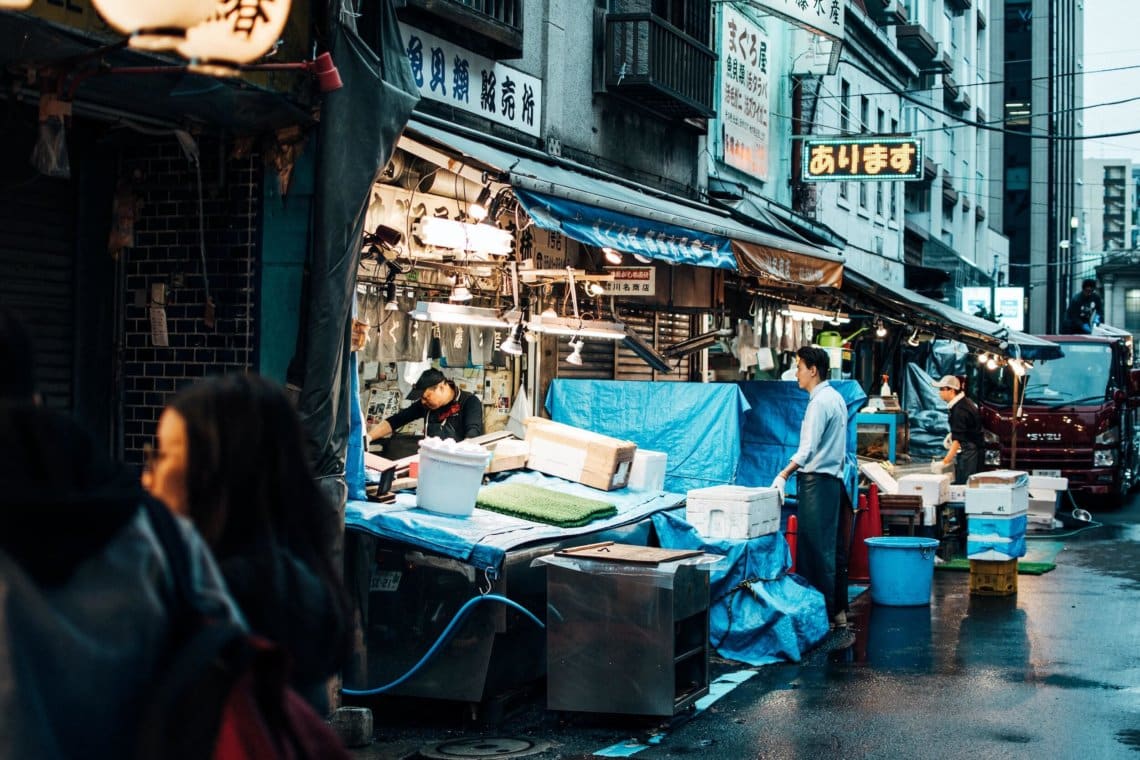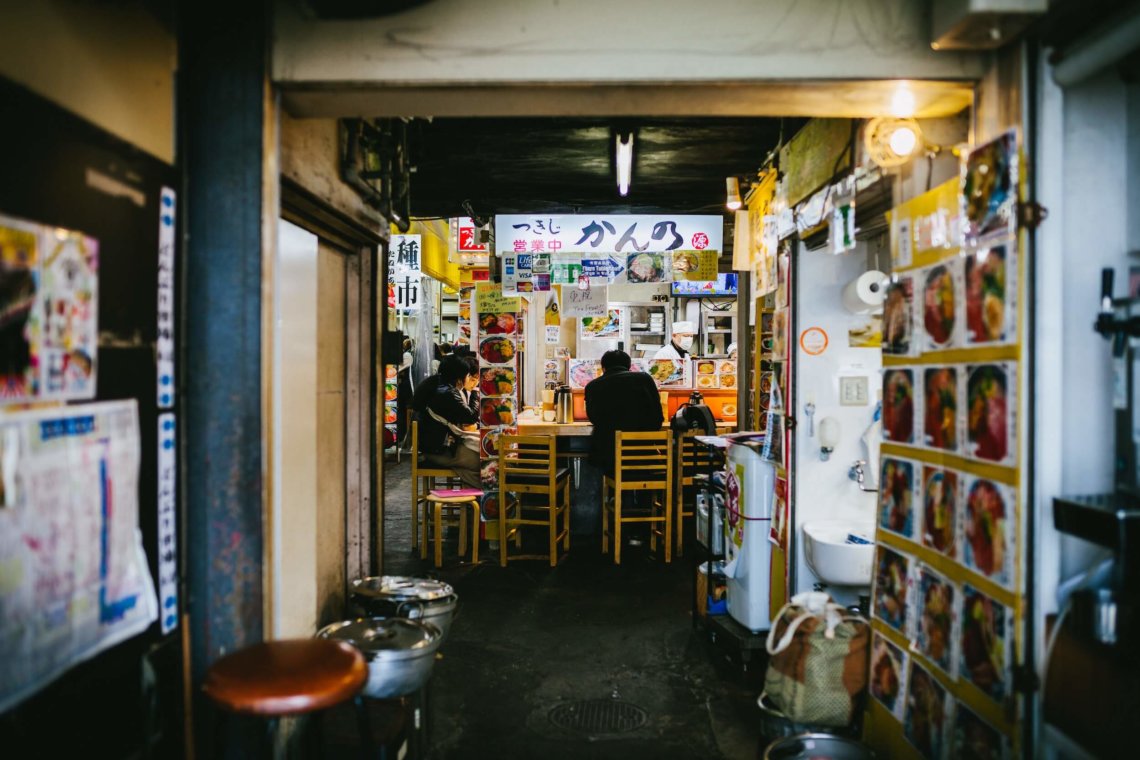Even with the opening of Toyosu Market, the classic Tsukiji Market in Tokyo remains one of Japan’s most iconic and historic marketplaces and a must-visit for food lovers.
In 2018, Tsukiji Fish Market’s wholesale operations moved to Toyosu, and to this day travelers often ask us if visiting Tsukiji is still worthwhile. The answer is a wholehearted yes, and we’ve put together this up-to-date guide on visiting the one-and-only Tsukiji Shijo.
Originally written in 2014, this post was updated and republished on June 6, 2022.

Tsukiji Basics: Jonai (Inner Market) vs. Jogai (Outer Market)
You’ve probably heard that Tsukiji Fish Market closed and moved to Toyosu, but this is only partly true.
Tsukiji was always divided into two main sections: the inner wholesale market (jonai) geared towards professionals, and the outer market (jogai) open to the public.
Side note, in case you’re wondering: jo- in this context means market, and -nai and -gai mean inner and outer, respectively. For more Japanese language tips, see our 20 Essential Japanese Phrases for Travelers to Japan.
Tsukiji’s Inner Wholesale Market (Jonai)
This is the section of the market that closed down and moved to the Toyosu district of Tokyo in 2018.
Many years ago, when Tsukiji Fish Market originally began to attract travelers, its highlights were both the outer public portion of the market, as well as the inner jonai intended for restaurateurs and other culinary professionals.
Then, in the handful of years leading up to the market’s move, Japan experienced an astonishing tourism boom, while culinary travel simultaneously became a global phenomenon.
As a result, overcrowding became a dire issue at Tsukiji, particularly in the inner market where the increase in tourism began to interfere with seafood vendors and chefs going about their daily business.
For a feel of what Tsukiji’s inner market used to be like, watch the film Jiro Dreams of Sushi, or check out the Asahi Shimbun’s Tsukiji: Kitchen of the Times.
To help preserve the integrity of the market’s operations, increasingly stringent regulations were put into place to prevent tourists from entering the inner market until later and later. (At the time of Tsukiji’s move to Toyosu in October 2018, the permitted entry time was 11 am, by which point activity in the inner market had dwindled significantly.)
So while the inner market used to be part of its appeal, Tsukiji’s jogai (the outer market) ultimately became the highlight for most food-loving travelers in the years preceding the move.
Tsukiji’s Outer Market (Jogai)
As more and more travelers shifted their focus to Tsukiji’s outer market, it became obvious to visitors and locals alike that the historic Tsukiji jogai remains an extraordinary place to immerse yourself in Japanese cuisine.
In the lively and colorful outer market, you will find historic lanes and alleys packed with a colorful array of shops and small restaurants – not to mention atmosphere and charm to spare.

Highlights of Tsukiji’s Outer Market
The outer market’s vintage atmosphere and gritty charm are reason enough to visit, if you’re the type of traveler who loves exploring old streets that are brimming with character.
Most people visit Tsukiji for the food and culinary supplies, and as you wander through Tsukiji’s outer market you’ll come across:
- Tiny sushi shops
- Casual ramen stalls
- Vendors selling everything from fresh seafood to fruits and vegetables
- Purveyors of Japanese staples such as tea, kombu, katsuobushi, and nori
- Premium Japanese knives
- And much more
If you love to cook, the jogai is a fantastic place to stock up on Japanese ingredients for your pantry, not to mention buy a top-quality Japanese knife!
There are also countless places to eat at Tsukiji, though you will find that some shops have long lines from early in the morning. Also, keep in mind that while it can be fun to eat at the market, Tsukiji is not always the best place to enjoy Tokyo’s highest-quality sushi.
If you plan to make any purchases, make sure to bring cash, as some shops don’t accept credit or debit cards (read more about cash, ATMs, and credit cards in Japan).

Tips on Visiting Tsukiji Market
Here are some tips to help you get the most out of your visit to Tokyo’s Tsukiji Market.
1. Check Tsukiji Market Hours Before You Go
Most of Tsukiji’s shops and restaurants are closed on Sundays and national holidays, and many close on Wednesdays as well. Keep in mind that hours vary from shop to shop, so if you have a specific destination in mind, double-check the schedule in advance.
2. Morning Is the Best Time to Visit Tsukiji Market
As noted above, opening hours vary from establishment to establishment, but most of Tsukiji’s shops and restaurants tend to open in the morning and stay open until early afternoon. So we typically recommend visiting in the morning, when the market is most active.
3. Respect Tsukiji Market Etiquette
Most of this is common sense, and these etiquette tips apply to most any market or shop in Japan (for more on manners, see Japanese Etiquette 101):
- Be aware of your surroundings. This is a working marketplace, and you don’t want to impede locals from shopping at their local businesses.
- Ask for permission before photographing goods or people. Even if you don’t speak Japanese and they don’t speak English, sign language usually does the trick.
- Avoid perfume or cologne as this can interfere with others’ sense of smell and taste. This applies to general dining etiquette in Japan, as well.
- Travel light. Leave suitcases or large backpacks at your hotel or in a station locker.
- As noted above, make sure to have some cash on hand!
4. How to Get to Tsukiji Market
Tsukiji Market is located in the heart of central Tokyo, near the upscale Ginza neighborhood, the lovely Hamarikyu Garden, and lively Shimbashi.
If you have time, we recommend combining your visit to Tsukiji with a depachika (department store food hall) in Ginza, which is home to some of Tokyo’s best.
It’s a short and pleasant walk from Ginza to Tsukiji, but if you’re coming from another part of town here are the most common transport options to Tsukiji Market:
- If you’re traveling by public transit, the closest station is the Toei Oedo line’s Tsukiji Shijo Station.
- Also nearby, the second closest station is the Tokyo Metro Hibiya line’s Tsukiji Station.
- Naturally, you can also walk or take a taxi, depending on your point of origin.

Visiting the New Toyosu Market
Now that the wholesale operations have moved from historic Tsukiji to modern Toyosu, many travelers wonder whether they should visit Tsukiji, Toyosu, or both.
It’s not a simple answer, but we recommend focusing on Tsukiji, especially if you only want (or have time) to visit one. Apart from the fact that its location is a little bit out of the way, the modern Toyosu Market lacks the old-fashioned feel of Tsukiji.
The new Toyosu Market complex will hold some appeal to market lovers and also boasts many eateries. However, please note that it is not possible to independently enter the active market itself, and market activities can primarily be viewed from observation decks enclosed by glass.
We hope our guide has been helpful and that you enjoy your visit to Tokyo’s one-of-a-kind Tsukiji Market!


